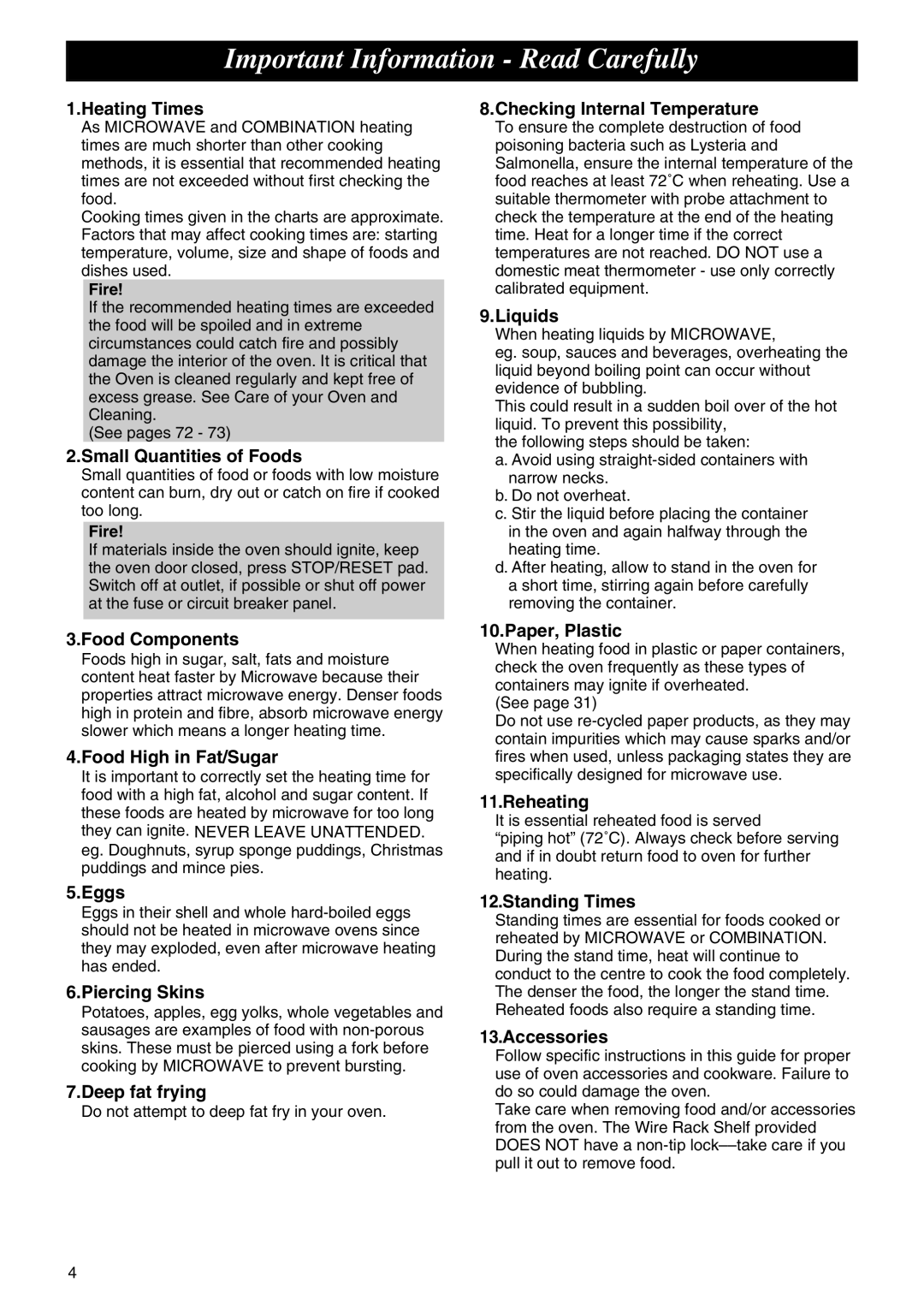
Important Information - Read Carefully
1.Heating Times
As MICROWAVE and COMBINATION heating times are much shorter than other cooking methods, it is essential that recommended heating times are not exceeded without first checking the food.
Cooking times given in the charts are approximate. Factors that may affect cooking times are: starting temperature, volume, size and shape of foods and dishes used.
Fire!
If the recommended heating times are exceeded the food will be spoiled and in extreme circumstances could catch fire and possibly damage the interior of the oven. It is critical that the Oven is cleaned regularly and kept free of excess grease. See Care of your Oven and Cleaning.
(See pages 72 - 73)
2.Small Quantities of Foods
Small quantities of food or foods with low moisture content can burn, dry out or catch on fire if cooked too long.
Fire!
If materials inside the oven should ignite, keep the oven door closed, press STOP/RESET pad. Switch off at outlet, if possible or shut off power at the fuse or circuit breaker panel.
3.Food Components
Foods high in sugar, salt, fats and moisture content heat faster by Microwave because their properties attract microwave energy. Denser foods high in protein and fibre, absorb microwave energy slower which means a longer heating time.
4.Food High in Fat/Sugar
It is important to correctly set the heating time for food with a high fat, alcohol and sugar content. If these foods are heated by microwave for too long they can ignite. NEVER LEAVE UNATTENDED. eg. Doughnuts, syrup sponge puddings, Christmas puddings and mince pies.
5.Eggs
Eggs in their shell and whole
6.Piercing Skins
Potatoes, apples, egg yolks, whole vegetables and sausages are examples of food with
7.Deep fat frying
Do not attempt to deep fat fry in your oven.
8.Checking Internal Temperature
To ensure the complete destruction of food poisoning bacteria such as Lysteria and Salmonella, ensure the internal temperature of the food reaches at least 72˚C when reheating. Use a suitable thermometer with probe attachment to check the temperature at the end of the heating time. Heat for a longer time if the correct temperatures are not reached. DO NOT use a domestic meat thermometer - use only correctly calibrated equipment.
9.Liquids
When heating liquids by MICROWAVE,
eg. soup, sauces and beverages, overheating the liquid beyond boiling point can occur without evidence of bubbling.
This could result in a sudden boil over of the hot liquid. To prevent this possibility,
the following steps should be taken:
a. Avoid using
b. Do not overheat.
c. Stir the liquid before placing the container in the oven and again halfway through the heating time.
d. After heating, allow to stand in the oven for a short time, stirring again before carefully removing the container.
10.Paper, Plastic
When heating food in plastic or paper containers, check the oven frequently as these types of containers may ignite if overheated.
(See page 31)
Do not use
11.Reheating
It is essential reheated food is served
“piping hot” (72˚C). Always check before serving and if in doubt return food to oven for further heating.
12.Standing Times
Standing times are essential for foods cooked or reheated by MICROWAVE or COMBINATION. During the stand time, heat will continue to conduct to the centre to cook the food completely. The denser the food, the longer the stand time. Reheated foods also require a standing time.
13.Accessories
Follow specific instructions in this guide for proper use of oven accessories and cookware. Failure to do so could damage the oven.
Take care when removing food and/or accessories from the oven. The Wire Rack Shelf provided DOES NOT have a
4
